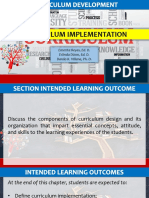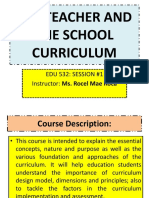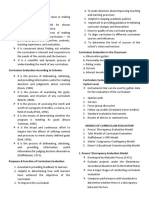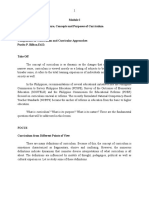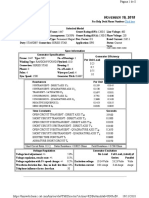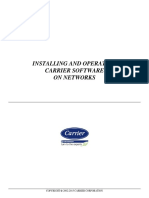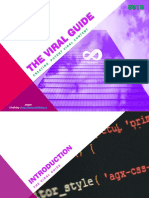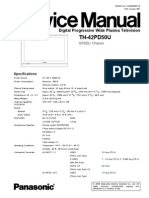100%(1)100% found this document useful (1 vote)
677 viewsCurriculum Implementation
Curriculum Implementation
Uploaded by
Joel HinayThe document discusses curriculum implementation which occurs between developing an educational plan and evaluating/revising the curriculum. A curriculum will be implemented in an actual school setting to determine if it achieves its goals, with revisions made based on teacher feedback. Implementing a curriculum focuses not just on actual use but also teacher attitudes, as they can choose between options. Teachers play a critical role in testing new curricula in classrooms and providing input during operational tryouts.
Copyright:
© All Rights Reserved
Available Formats
Download as DOCX, PDF, TXT or read online from Scribd
Curriculum Implementation
Curriculum Implementation
Uploaded by
Joel Hinay100%(1)100% found this document useful (1 vote)
677 views4 pagesThe document discusses curriculum implementation which occurs between developing an educational plan and evaluating/revising the curriculum. A curriculum will be implemented in an actual school setting to determine if it achieves its goals, with revisions made based on teacher feedback. Implementing a curriculum focuses not just on actual use but also teacher attitudes, as they can choose between options. Teachers play a critical role in testing new curricula in classrooms and providing input during operational tryouts.
Original Description:
Guidelines in implementing curriculum
Copyright
© © All Rights Reserved
Available Formats
DOCX, PDF, TXT or read online from Scribd
Share this document
Did you find this document useful?
Is this content inappropriate?
The document discusses curriculum implementation which occurs between developing an educational plan and evaluating/revising the curriculum. A curriculum will be implemented in an actual school setting to determine if it achieves its goals, with revisions made based on teacher feedback. Implementing a curriculum focuses not just on actual use but also teacher attitudes, as they can choose between options. Teachers play a critical role in testing new curricula in classrooms and providing input during operational tryouts.
Copyright:
© All Rights Reserved
Available Formats
Download as DOCX, PDF, TXT or read online from Scribd
Download as docx, pdf, or txt
100%(1)100% found this document useful (1 vote)
677 views4 pagesCurriculum Implementation
Curriculum Implementation
Uploaded by
Joel HinayThe document discusses curriculum implementation which occurs between developing an educational plan and evaluating/revising the curriculum. A curriculum will be implemented in an actual school setting to determine if it achieves its goals, with revisions made based on teacher feedback. Implementing a curriculum focuses not just on actual use but also teacher attitudes, as they can choose between options. Teachers play a critical role in testing new curricula in classrooms and providing input during operational tryouts.
Copyright:
© All Rights Reserved
Available Formats
Download as DOCX, PDF, TXT or read online from Scribd
Download as docx, pdf, or txt
You are on page 1of 4
CURRICULUM IMPLEMENTATION
Curriculum implementation is expected to occur between Component 4 (educational plan) and
Component 5 (evaluation and revision) of Kellough and Kelloughs curriculum development model.
The curriculum will be implemented with the help of teachers in an actual school setting and find out if
the curriculum is achieving its goal. After testing the curriculum in real-life settings, revisions can be
made based on teacher feedback. Then, full-scale implementation shall take place. At a certain
point, there is a need to evaluate the curriculum to make any necessary changes.
A school curriculum develops from a plan. Careful planning and development are obviously
important, but these count for nothing unless teachers are familiar with the curriculum and have the
skills to implement it in their classes.
The term implementation refers to the actual use of the curriculum or syllabus or what it consists of in
practice. Implementation is a critical phase in the cycles of planning and teaching a curriculum. The
adoption of a curriculum refers to ones intention to use the curriculum, be it as a teacher or a school
head, but the adoption does not indicate whether the curriculum is implemented or not.
Implementing the curriculum does not only focus on the actual use but also on the attitudes of those
who implement it. These attitudinal dispositions are particularly important in educational systems
where teachers and principals have the opportunity to choose among competing curriculum
packages. For example, if teachers think that curriculum being implemented is lacking in certain
aspects, they can look for other curricula that address these gaps or problems, In most cases,
teachers implement new school curricula only if they think that something is wrong with the one they
are currently implementing. This curriculum dysfunction may be due to a gap between what it
perceived as the ideal practice and what the current curriculum offers in reference to a particular
subject.
In many instances and in almost all subject areas, a new curriculum is formulated at a higher level
(national or district) to be used by all teachers. No alternative curricular choices are given. In a way,
the teachers are tasked to test a new curriculum in actual school setting. Teachers get a chance to
provide inputs into the new curriculum at the operational tryout. They work side by side with the
curriculum developers.
Preliminaries to Curriculum Implementation
Teachers as the implementers of the curriculum would have a lot of questions on how to use a
new curriculum. As experts in hands-on application of a curriculum, teachers can tell if they feel
comfortable using a particular approach or material in teaching students. It naturally takes time
before teachers become competent and confident in using a new curriculum.
When teachers have already mastered the new curriculum and are already implementing it as
a matter of routine, the use of the curriculum becomes spontaneous and natural. This is called as
the stage of curricular institutionalization. This stage refers to the period when the new curriculum
has been effectively ingrained into the schools daily functions. All teachers are implementing the
prescribed curriculum.
How Should a Curriculum Be Implemented?
There are two extreme views about curriculum implementation. One view is the Laissez-faire
approach or the let alone approach, which gives the teachers the absolute power to determine what
they see best to implement in the classroom. At the other end of these extreme, is the Authoritarian
control. In this view, teachers are directed by authority figures through a memorandum to follow a
curriculum. Teachers have no control or leeway over the subjects they are teaching. School heads
exercise absolute power in directing teachers to teach certain subjects in specified ways.
Approaches to Optimize Curriculum Opportunities
A realistic view of curriculum implementation should be between the two extremes. Teachers
are expected to follow the prescribed syllabus exactly and make sure that they do not miss any
topic/component. When teachers diligently follow a prescribed syllabus in teaching a lesson, then
they are considered to have fidelity of use or fidelity of implementation. To promote fidelity of use,
first you need to identify the topics or subjects that need more focus. These subjects are those that
are more technical or more difficult. A structured approach to implementation is then followed, one in
which teachers are provided clear instructions early on. Teachers should be familiar with and well
trained on the more important topic/s. They should have also developed the needed skills to translate
the curriculum into actual lessons inside the classroom and beyond.
On the other hand, some topics allow or encourage teachers to be creative and unique in
teaching these topics. Teachers can implement personalized variations of the prescribed curriculum
but still be guided by it. This is referred to as adaptation to the curriculum or process orientation.
Process orientation comes as a response to acknowledge different organizational contexts and
varying teachers needs and abilities that would require on-site modification.
Curriculum Implementation Perspectives
1. Technical Perspective. This considers the impact of planning and availability of resources in
program implementation.
2. Political Perspective. This considers the balance of power that determines the success of the
curriculum.
3. Cultural Perspective. This puts emphasis on the beliefs and ways of behaving in a society that
ultimately affect what happens inside the classroom.
Factors Affecting Curriculum Implementation
A. According to Fullan, 1982
1. Characteristics of change
a. Need and relevant to change
b. clarity
c. complexity
d. quality and practicality of the program
2. Characteristics at the school district level
a. the history of innovative attempts
b. the adoption process
c. Central administrative support and involvement
d. self-development and participation
e. timeline and information system
f. Board and community characteristics
3. Characteristics at the school level
a. the principal
b. teacher-teacher relations
c. teacher characteristics and orientations
4. Characteristics external to the local system
a. role of government
b. external assistance
B. Others
1. The teacher
2. The learners
3. Resource Materials and facilities
4. Interest groups are local companies, organizations, stakeholders who can influence
implementation by: a. provide financial aids;
b. demand inclusion of certain subjects; and
c. influence learners to reject courses they consider detrimental to the interest
group.
5. School environment
6. Culture and ideology
7. Instructional supervision
8. Assessment
Factors in Promoting Successful Curriculum Implementation
1. The need for time - to experiment for attitudes to change
2. A technology for change
3. Recognition of the school culture
4. Incentives and rewards
5. Sharing of burden in the workplace
6. Releasing of energy for innovation
7. A collaborative framework
8. Leadership
9. Recognition of the system-level culture
10. The need for political perspective
11. The need to win allies
12. Recognition of the role of individuals.
Reflective Essay: (Answer in a one whole sheet of paper)
1. Imagine that you are a teacher tasked by your principal to implement a new curriculum. What would be
your questions on the new curriculum? What would be your concerns? Write down at least 5 questions
(1point each)
2. You have read from this article that teacher is an important factor in the implementation of a prescribed
curriculum, how can this be so? (5 points)
3. From the article, what can be considered as elements in curriculum implementation? Please list them. ( 5
points)
4. We have discussed about curriculum institutionalization. How do you know if there is curricular
institutionalization is a school? List down 4 reasons (2 points each)
/E. de Peralta (1st Sem 2013-14)
You might also like
- Curriculum ImplementationDocument11 pagesCurriculum ImplementationMajjesty Anne Villahermosa Caumeran88% (8)
- Curriculum Approaches and FoundationDocument9 pagesCurriculum Approaches and FoundationRodrick Sonajo Ramos100% (2)
- Curriculum ImplementationDocument25 pagesCurriculum ImplementationShantiram Dahal100% (5)
- Rules and Regulations To Follow in This ParentsDocument1 pageRules and Regulations To Follow in This ParentsJoel Hinay100% (2)
- Curriculum Change and InnovationDocument14 pagesCurriculum Change and InnovationJoel Hinay100% (10)
- Curriculum Change and InnovationDocument14 pagesCurriculum Change and InnovationJoel Hinay100% (10)
- The Life-Changing Magic of Tidying Up THDocument3 pagesThe Life-Changing Magic of Tidying Up THCristina Arhip0% (1)
- Aeg Lav 4742Document21 pagesAeg Lav 4742valehan526No ratings yet
- Maven Cheat SheetDocument1 pageMaven Cheat SheetMonica GellerNo ratings yet
- Curriculum DevelopmentDocument13 pagesCurriculum DevelopmentDione Christy Brua0% (1)
- Curriculum Implementation HandoutsDocument3 pagesCurriculum Implementation HandoutsChristine Joy PerionNo ratings yet
- Curriculum DevelopmentDocument10 pagesCurriculum DevelopmentJhenalyn Perlada100% (1)
- Module 5 Curriculum ImplementationDocument38 pagesModule 5 Curriculum ImplementationRen Ren100% (5)
- Curriculum Implementation ExplanationDocument6 pagesCurriculum Implementation ExplanationFlorencioNo ratings yet
- Role of The Teacher in Curriculum DevelopmentDocument18 pagesRole of The Teacher in Curriculum Developmentgiven kalukanguNo ratings yet
- "Curriculum Evaluation Is Too Important To Be Left To Teachers." DiscussDocument19 pages"Curriculum Evaluation Is Too Important To Be Left To Teachers." DiscussHwee Kiat Ng100% (12)
- Curriculum Process and ModelsDocument4 pagesCurriculum Process and ModelsRodrick Sonajo Ramos100% (1)
- Curriculum ApproachesDocument8 pagesCurriculum ApproachesMarvin VinasNo ratings yet
- Teacher Participation in Curriculum DevelopmentDocument15 pagesTeacher Participation in Curriculum DevelopmentVarah ORlandosNo ratings yet
- Curriculum Development March 3Document59 pagesCurriculum Development March 3Mary Rose QuimanjanNo ratings yet
- Hilda Taba Model LlacunaDocument14 pagesHilda Taba Model Llacunaabigail zagadoNo ratings yet
- CurriculumDocument72 pagesCurriculummgar10100% (4)
- Types of Teaching ApproachesDocument20 pagesTypes of Teaching ApproachesArah Madilat100% (1)
- Prepared By: Nenia Jane V. GloriaDocument15 pagesPrepared By: Nenia Jane V. GloriaJessica Alparaz0% (1)
- 8603-1 SanaDocument28 pages8603-1 SanaAreeba M.jNo ratings yet
- Curriculum Change and InnovationDocument10 pagesCurriculum Change and InnovationRaquel M. MendozaNo ratings yet
- Different Models of CurriculumDocument17 pagesDifferent Models of Curriculumjolsc100% (3)
- Edu 532 The TeacherDocument17 pagesEdu 532 The TeacherRocel Mae Casiño RocaNo ratings yet
- Process and Models of Curriculum DevelopmentDocument5 pagesProcess and Models of Curriculum DevelopmentDiana Morilla Azna100% (1)
- Chapter 1 Lesson 3 Curriculum Development Process and ModelDocument17 pagesChapter 1 Lesson 3 Curriculum Development Process and ModelAriell EmraduraNo ratings yet
- Concept of CurriculumDocument1 pageConcept of CurriculumDani Sayuti100% (1)
- Curriculum EvaluationDocument20 pagesCurriculum EvaluationOsman Yavasca100% (2)
- Educational Planning and Curriculum DevelopmentDocument46 pagesEducational Planning and Curriculum DevelopmentRhea O. Marimla100% (3)
- Needs Assessment and Selection of Course in The CurriculumDocument33 pagesNeeds Assessment and Selection of Course in The Curriculummarie nellNo ratings yet
- Curriculum EvaluationDocument9 pagesCurriculum EvaluationCha'win MN100% (1)
- Teaching Learning Process and Curriculum DevelopmentDocument14 pagesTeaching Learning Process and Curriculum DevelopmentSelina Louis Chen Tien50% (4)
- Curriculum Development Module 2 Lesson 1 and 2Document7 pagesCurriculum Development Module 2 Lesson 1 and 2Jireh Albay100% (1)
- Chapter 3 - FINAL CurriculumDocument79 pagesChapter 3 - FINAL CurriculumMitch ComiaNo ratings yet
- Curriculum Evaluation 2019Document5 pagesCurriculum Evaluation 2019Joash Matthew S. Castro100% (1)
- Curriculum DevelopmentDocument12 pagesCurriculum DevelopmentBernice Esteban90% (21)
- The Nature of CurriculumDocument30 pagesThe Nature of CurriculumOmar Santiago Bastias90% (10)
- Module 3 Lesson 1 Fundamentals of Curriculum DesigningDocument9 pagesModule 3 Lesson 1 Fundamentals of Curriculum DesigningCerize Parado100% (2)
- The Teacher As A Knower of Curriculum: Curriculum Development: Processes and ModelsDocument22 pagesThe Teacher As A Knower of Curriculum: Curriculum Development: Processes and Modelsjezryl calapanNo ratings yet
- Educational LeadershipDocument23 pagesEducational LeadershipMaia Emberglow50% (2)
- LESSON 3 Curriculum DevelopmentDocument20 pagesLESSON 3 Curriculum DevelopmentMaria Ronavie Davalos MantesNo ratings yet
- Teacher Centered Curriculum, The Role of Teachers & CurriculumDocument7 pagesTeacher Centered Curriculum, The Role of Teachers & CurriculumLawan YusufNo ratings yet
- Curriculum EvaluationDocument55 pagesCurriculum EvaluationRobert S. Deligero50% (2)
- Curriculum DesignDocument45 pagesCurriculum DesignAntonio Delgado100% (1)
- Curriculum EvaluationDocument3 pagesCurriculum EvaluationLovely Valencia50% (2)
- Module IDocument36 pagesModule IMyka Andrea Panganiban Garcia100% (4)
- Chapter 1 Module 2 Lesson 3 Curriculum Dev Process ModelsDocument26 pagesChapter 1 Module 2 Lesson 3 Curriculum Dev Process ModelsHazim Gomer Dognap50% (2)
- Reflection Paper On Historical Basis of CurriculumDocument2 pagesReflection Paper On Historical Basis of CurriculumMary Jane LayaogNo ratings yet
- Foundation of Curriculum FinalDocument209 pagesFoundation of Curriculum FinalSilambu Arasan90% (48)
- Educ Planning HandoutDocument2 pagesEduc Planning HandouticeberghoneyNo ratings yet
- Learner-Centered Teaching What Makes It EffectiveDocument11 pagesLearner-Centered Teaching What Makes It EffectiveDiemie AbellanosaNo ratings yet
- Curriculum DevelopmentDocument19 pagesCurriculum DevelopmentCarla Joyce67% (6)
- Curriculum Evaluation - HardDocument6 pagesCurriculum Evaluation - HardRudy Gel C. Villaruz0% (1)
- Conceptual Framework of Teachers' Competence in Relation To Students' Academic AchievementDocument6 pagesConceptual Framework of Teachers' Competence in Relation To Students' Academic AchievementWARSE Journals67% (3)
- Curriculum DesignDocument24 pagesCurriculum DesignHaziqah Izam100% (2)
- Philosophy of EducationDocument2 pagesPhilosophy of EducationarenroferosNo ratings yet
- Foundations of Education, Mid Term SolvedDocument7 pagesFoundations of Education, Mid Term SolvedXee XeeNo ratings yet
- Handbook of Research on TeachingFrom EverandHandbook of Research on TeachingCourtney BellNo ratings yet
- Enhancing Competency of Teachers: A Teaching-And-Learning Enhancement GuideFrom EverandEnhancing Competency of Teachers: A Teaching-And-Learning Enhancement GuideNo ratings yet
- Educating Learners With Visual Impairment In ZambiaFrom EverandEducating Learners With Visual Impairment In ZambiaRating: 5 out of 5 stars5/5 (1)
- Curriculum ImplementationDocument11 pagesCurriculum ImplementationMarj Abesamis100% (1)
- Pre-Test and Post-TestDocument2 pagesPre-Test and Post-TestJoel HinayNo ratings yet
- Program Evaluation: Table 1Document3 pagesProgram Evaluation: Table 1Joel HinayNo ratings yet
- Rizal National High SchoolDocument4 pagesRizal National High SchoolJoel HinayNo ratings yet
- Hinay, Joel A.: Group Count Sum Mean Variance SS STD Err Lower UpperDocument3 pagesHinay, Joel A.: Group Count Sum Mean Variance SS STD Err Lower UpperJoel HinayNo ratings yet
- Mappings: Let F: R R Defined by F (X) X - 4x. Find Im (F) - Is F Onto R? Is F One-One?Document2 pagesMappings: Let F: R R Defined by F (X) X - 4x. Find Im (F) - Is F Onto R? Is F One-One?Joel HinayNo ratings yet
- Binary Operations: Is Associative.Document1 pageBinary Operations: Is Associative.Joel HinayNo ratings yet
- GCD and CongruenceDocument4 pagesGCD and CongruenceJoel HinayNo ratings yet
- Systems of Linear Equation (Handouts)Document6 pagesSystems of Linear Equation (Handouts)Joel HinayNo ratings yet
- CircleDocument9 pagesCircleJoel HinayNo ratings yet
- My Rules. My Class.: Joel A. HinayDocument2 pagesMy Rules. My Class.: Joel A. HinayJoel HinayNo ratings yet
- Patterns of Curriculum DesigningDocument2 pagesPatterns of Curriculum DesigningJoel Hinay86% (36)
- Generator DataDocument8 pagesGenerator Dataramirex_umsaNo ratings yet
- AEM Certification QuestionsDocument8 pagesAEM Certification Questionsvinod baggaNo ratings yet
- Signal Line 256 Gray Level 3 Channel Constant Current LED Driver ICDocument8 pagesSignal Line 256 Gray Level 3 Channel Constant Current LED Driver ICsteven MelgarejoNo ratings yet
- Balibago Primero Integrated School: T A B L E of S P E C I F I C A T I O NDocument1 pageBalibago Primero Integrated School: T A B L E of S P E C I F I C A T I O NBintawan Nhs Wndl AkinoNo ratings yet
- Rankine ReheatDocument2 pagesRankine ReheatManik SinghNo ratings yet
- Selcom Pay Change Request Form - Sept 2022Document1 pageSelcom Pay Change Request Form - Sept 2022AFROIL MUSOMANo ratings yet
- User Guide Ibim8665 PDFDocument96 pagesUser Guide Ibim8665 PDFpavithra2No ratings yet
- Tugas Manajemen Kontrak Kelompok 1Document78 pagesTugas Manajemen Kontrak Kelompok 1Yulius IndhraNo ratings yet
- Automotive Cockpit HMIDocument2 pagesAutomotive Cockpit HMIIQPC GmbHNo ratings yet
- Reference ManualDocument65 pagesReference ManualTeddy Jhennse Negrete PeñaNo ratings yet
- Experiment 2Document17 pagesExperiment 2Anusha AnuNo ratings yet
- Strong Interest Inventory Manual 2012 SupplementDocument129 pagesStrong Interest Inventory Manual 2012 SupplementBobby Antonio0% (1)
- Installing Dimensions Component Pack 3.5Document9 pagesInstalling Dimensions Component Pack 3.5Nakal19No ratings yet
- Reflections On Managing WaterDocument282 pagesReflections On Managing WaterBalipara FoundationNo ratings yet
- Introduction From Brewing Science, Technology and Print, 1700-1880Document10 pagesIntroduction From Brewing Science, Technology and Print, 1700-1880Pickering and ChattoNo ratings yet
- Installing and Operating Carrier Software On NetworksDocument11 pagesInstalling and Operating Carrier Software On NetworksFaquruddin AliNo ratings yet
- Creating Viral Content: The Viral GuideDocument28 pagesCreating Viral Content: The Viral GuideTrap Sta100% (3)
- PUCIT - Lec2 PDFDocument28 pagesPUCIT - Lec2 PDFMOHAMMAD HARISNo ratings yet
- Service (Repair) Manual For Panasonic TH-42PD50UDocument60 pagesService (Repair) Manual For Panasonic TH-42PD50UCasteloencantado100% (1)
- Alta SARM Release8Document320 pagesAlta SARM Release8Geoff BrownNo ratings yet
- RC 16 Apr 2022Document7 pagesRC 16 Apr 2022Mary CharlesNo ratings yet
- Integrated Membrane Operations in The Food Production 113Document377 pagesIntegrated Membrane Operations in The Food Production 113Yiğit Ilgaz100% (1)
- EBR9900 - BuiltinKitInstructions - GB DE FR NL IT ESDocument17 pagesEBR9900 - BuiltinKitInstructions - GB DE FR NL IT ESAnonymous PL3wzykNo ratings yet
- Engaging Youth in Community Decision Making PDFDocument94 pagesEngaging Youth in Community Decision Making PDFalvin umahonNo ratings yet
- 15 Aturan TipografiDocument16 pages15 Aturan TipografiAndi Miswar Arman100% (1)
- Ansi b151.1 RG-687Document13 pagesAnsi b151.1 RG-687luisulloaimNo ratings yet
- Model 1 DS1703Document2 pagesModel 1 DS1703dreyko77No ratings yet












